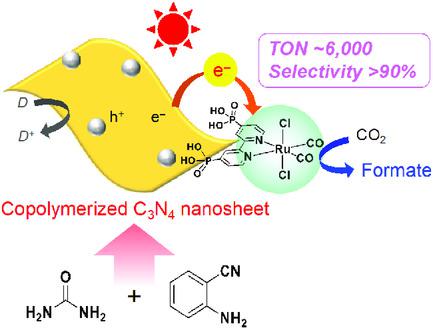Our official English website, www.x-mol.net, welcomes your
feedback! (Note: you will need to create a separate account there.)
Synthesis of Copolymerized Carbon Nitride Nanosheets from Urea and 2‐Aminobenzonitrile for Enhanced Visible Light CO2 Reduction with a Ruthenium(II) Complex Catalyst
Solar RRL ( IF 6.0 ) Pub Date : 2019-12-19 , DOI: 10.1002/solr.201900461 Kengo Shibata 1 , Kosaku Kato 2 , Constantine Tsounis 3 , Tomoki Kanazawa 1, 4 , Daling Lu 5 , Shunsuke Nozawa 6 , Akira Yamakata 2 , Osamu Ishitani 1 , Kazuhiko Maeda 1
Solar RRL ( IF 6.0 ) Pub Date : 2019-12-19 , DOI: 10.1002/solr.201900461 Kengo Shibata 1 , Kosaku Kato 2 , Constantine Tsounis 3 , Tomoki Kanazawa 1, 4 , Daling Lu 5 , Shunsuke Nozawa 6 , Akira Yamakata 2 , Osamu Ishitani 1 , Kazuhiko Maeda 1
Affiliation

|
Copolymerized carbon nitride nanosheets (NS‐C3N4) are synthesized by heating a mixture of urea and 2‐aminobenzonitrile (ABN) at 823 K for 2 h in air. The visible light‐absorption capability of the copolymerized NS‐C3N4 can be improved with an increase in the ABN content in the starting material, while maintaining the rather negative conduction band potential of NS‐C3N4. With the aid of a ruthenium(II) complex catalyst, the copolymerized NS‐C3N4 becomes active for CO2 reduction into formate (>90% selectivity) under visible light (λ > 400 nm) in the presence of triethanolamine as an electron donor. The activity is enhanced with increasing the starting ABN content to reach a maximum at a certain amount, beyond which it declines. The optimized material, modified with a silver promoter and a phosphonate‐functionalized ruthenium(II) catalyst, gives a high turnover number of 6000 (vs Ru catalyst) for formate production. Physicochemical analyses indicate that increasing the starting ABN concentration improves the visible light‐absorption capability of the copolymerized NS‐C3N4, but increases the number of trap states, which can work as recombination centers of photogenerated electrons and holes. Therefore, an appropriate adjustment of the ABN comonomer amount is essential to obtain copolymerized NS‐C3N4, which shows high photocatalytic activity.
中文翻译:

由尿素和2-氨基苄腈合成共聚氮化碳纳米片,用钌(II)络合物催化剂增强可见光CO 2还原
通过在空气中将尿素和2-氨基苄腈(ABN)的混合物在823 K下加热2 h来合成共聚氮化碳纳米片(NS-C 3 N 4)。原料中ABN含量的增加可以提高共聚NS-C 3 N 4的可见光吸收能力,同时保持NS-C 3 N 4的负导带电势。与钌(II)配合物催化剂的帮助下,共聚的NS-C 3 Ñ 4为CO变得活跃2在可见光下还原成甲酸盐(> 90%的选择性)(λ 大于400 nm)在三乙醇胺作为电子给体的情况下。通过增加起始ABN含量使其达到一定量的最大值,该活性会增强,然后降低。经过优化的材料,用银助催化剂和膦酸酯官能化的钌(II)催化剂改性,可生成6000的高周转率(与Ru催化剂相比)。物理化学分析表明,增加起始ABN浓度可提高共聚的NS-C 3 N 4的可见光吸收能力,但会增加陷阱态的数量,这可以作为光生电子和空穴的复合中心。因此,适当调整ABN共聚单体的量对于获得共聚的NS‐C 3是必不可少的N 4,显示出高的光催化活性。
更新日期:2019-12-19
中文翻译:

由尿素和2-氨基苄腈合成共聚氮化碳纳米片,用钌(II)络合物催化剂增强可见光CO 2还原
通过在空气中将尿素和2-氨基苄腈(ABN)的混合物在823 K下加热2 h来合成共聚氮化碳纳米片(NS-C 3 N 4)。原料中ABN含量的增加可以提高共聚NS-C 3 N 4的可见光吸收能力,同时保持NS-C 3 N 4的负导带电势。与钌(II)配合物催化剂的帮助下,共聚的NS-C 3 Ñ 4为CO变得活跃2在可见光下还原成甲酸盐(> 90%的选择性)(λ 大于400 nm)在三乙醇胺作为电子给体的情况下。通过增加起始ABN含量使其达到一定量的最大值,该活性会增强,然后降低。经过优化的材料,用银助催化剂和膦酸酯官能化的钌(II)催化剂改性,可生成6000的高周转率(与Ru催化剂相比)。物理化学分析表明,增加起始ABN浓度可提高共聚的NS-C 3 N 4的可见光吸收能力,但会增加陷阱态的数量,这可以作为光生电子和空穴的复合中心。因此,适当调整ABN共聚单体的量对于获得共聚的NS‐C 3是必不可少的N 4,显示出高的光催化活性。











































 京公网安备 11010802027423号
京公网安备 11010802027423号